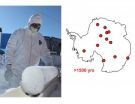(Press-News.org) As in humans, cancers in dogs have complex causes. The interaction of the environment, food, and genetic disposition are the most well known factors. Today nearly all methods of human medicine are basically available for dogs with cancer, but this was not true of cancer immunotherapy so far.
So-called cancer immunotherapy - which is the treatment of tumors by the use of antibodies - has been established and used very successfully in human medicine for about 20 years. Since cancer cells bear very specific antigens on the surface, the corresponding antibodies bind to these molecules and thus inhibit tumor growth. The mechanism that becomes effective is a destructive signal sent by the antibody to the inside of the cancer cell and initiates its death. In a second mechanism, the immune system of the patient also destroys the "marked" tumor in a more efficient way.
The target is nearly identical in humans and dogs
Josef Singer and Judith Fazekas, both lead authors of the study, discovered that a receptor frequently found on human tumor cells (epidermal growth factor receptor or EGFR) is nearly 100 percent identical with the EGF receptor in dogs. In human medicine EGFR is frequently used as the target of cancer immunotherapy because many cancer cells bear this receptor on their surface. The so-called anti-EGFR antibody binds to cancer cells and thus triggers the destruction of the cells. "Due to the high similarity of the receptor in humans and dogs, this type of therapy should work well in dogs too," the scientists say. The binding site of the antibody to EGFR in man and dogs differs only in respect of four amino acids.
Antibody trimmed to "dog"
To ensure best possible binding of the antibody to cancer cells in dogs, the human antibody had to be trimmed to "dog" in the laboratory. In human medicine this process is known as the "humanization" of an antibody. The antibody originally produced in the mouse has to be adjusted to the species for which it is used. Singer and Fazekas replaced the corresponding elements in the "humanized" antibody with elements from the dog. In experiments on dog cancer cells in the laboratory it was found that the newly developed antibodies did, in fact, bind to canine cancer cells with greater specificity.
The head of the study, Professor Erika Jensen-Jarolim, explains as follows: "We expect dogs to tolerate these anti-cancer antibodies well. This will be investigated in clinical studies in the future and is expected to greatly improve the treatment as well as the diagnosis of cancer in dogs."
Improvement of diagnosis
The newly developed antibody provides an additional benefit for dogs. As in human medicine, antibodies can be coupled with signal molecules. When the antibody binds to a cancer cell in the organism, the coupled antibody - in this case a radioactive isotope - can be rendered visible and is thus able to show where tumors and even metastases are located. When the selected isotope also contributes to the decay of cancer cells, the approach is known as "theranostics" (therapy and diagnostics).
"The Veterinary Medical University, Vienna will be the first center in the world to offer the most modern immunological cancer diagnosis procedure for dogs. Of special interest to me as a doctor of human medicine is the fact that, by using this approach, we will be able to initiate improvements that will benefit humans as well," says Jensen-Jarolim.
The first anti-EGFR antibody (cetuximab) for cancer treatment in human medicine was developed by the company Merck. In humans it is primarily used for the treatment of bowel cancer. Cancer immunotherapy is mainly applied in combination with chemotherapy and radiotherapy. In veterinary medicine, immunotherapy will be employed for the treatment of mammary ridge cancer (milk line cancer) in dogs. It may also be used as part of a combination therapy.
INFORMATION:
The article „Generation of a Canine Anti-EGFR (ErbB-1) Antibody for
Passive Immunotherapy in Dog Cancer Patients", by Josef Singer, Judit Fazekas, Wei Wang, Marlene Weichselbaumer, Miroslawa Matz, Alexander Mader, Willibald Steinfellner, Sarah Meitz, Diana Mechtcheriakova, Yuri Sobanov, Michael Willmann, Thomas Stockner, Edzard Spillner, Renate Kunert and Erika Jensen-Jarolim was published in the Journal Molecular Cancer Therapeutics. doi: 10.1158/1535-7163.MCT-13-0288
About the University of Veterinary Medicine, Vienna
The University of Veterinary Medicine, Vienna in Austria is one of the leading academic and research institutions in the field of Veterinary Sciences in Europe. About 1,200 employees and 2,300 students work on the campus in the north of Vienna which also houses five university clinics and various research sites. Outside of Vienna the university operates Teaching and Research Farms. http://www.vetmeduni.ac.at
Scientific Contact:
Prof. Erika Jensen-Jarolim
Messerli Research Institute – Comparative Medicine
University of Veterinary Medicine Vienna (Vetmeduni Vienna)
T +43 1 20577-2660
M +43 664 60257-6260
erika.jensen-jarolim@vetmeduni.ac.at
Released by:
Susanna Kautschitsch
Science Communication / Public Relations
University of Veterinary Medicine Vienna (Vetmeduni Vienna)
T +43 1 25077-1153
susanna.kautschitsch@vetmeduni.ac.at
First cancer immunotherapy for dogs developed
2014-07-07
ELSE PRESS RELEASES FROM THIS DATE:
Novel type of bird pollination mechanism discovered in South America
2014-07-07
The genus Axinaea belongs to the large, mainly tropical flowering plant family Melastomataceae (Meadow Beauty Family). Most of the ca. 5000 species in the family rely on bees for their pollination. Only about 100 are known to be pollinated by other insects or vertebrates. The flowers of Axinaea appear in clusters of few to more than twenty flowers and the petals of the different species are pink, yellow, orange or red. The stamens (male reproductive organs) stand out based on the contrasting colours of their bulbous appendages. The pollination mechanism of Axinaea had never ...
Pseudogenes may provide clearer understanding of biomarkers
2014-07-07
Alas, the thankless pseudogene.
Dysfunctional, unloved and seemingly of little use, these poor-cousin relatives of genes have lost their protein-coding abilities. They contain material not essential for an organism's survival and are the "last stop" for removal of genomic waste.
Not any more. The pseudogene's day may have arrived thanks to scientists at The University of Texas MD Anderson Cancer Center in Houston.
Han Liang, Ph.D., an assistant professor in the Department of Bioinformatics and Computational Biology at the Cancer Center is advancing knowledge of these ...
NYU researchers find 18 percent of high school seniors smoke hookah
2014-07-07
New York, NY – July 7, 2014 - While cigarette use is declining precipitously among youth, evidence indicates that American adolescents are turning to ethnically-linked alternative tobacco products, such as hookahs, cigars, and various smokeless tobacco products, according to a recent report from the Centers for Disease Control and Prevention (CDC).
Now a new study by researchers affiliated with New York University's Center for Drug Use and HIV Research (CDUHR), in the August 2014 edition of Pediatrics identifies how prevalent Hookah use is and which teens are most likely ...
Denali duck-billed dino tracks
2014-07-07
Boulder, Colo., USA – A trio of paleontologists has discovered a remarkable new tracksite in Alaska's Denali National Park filled with duck-billed dinosaur footprints -- technically referred to as hadrosaurs -- that demonstrates they not only lived in multi-generational herds but thrived in the ancient high-latitude, polar ecosystem. The paper provides new insight into the herd structure and paleobiology of northern polar dinosaurs in an arctic greenhouse world.
The article, "Herd structure in Late Cretaceous polar dinosaurs: A remarkable new dinosaur tracksite, Denali ...
Babies born to healthy mums worldwide are strikingly similar in size
2014-07-07
Babies' growth in the womb and their size at birth, especially their length, are strikingly similar the world over – when babies are born to healthy, well-educated and well-nourished mothers.
That's the finding of a landmark international study, INTERGROWTH-21st, led by Oxford University researchers, which involved almost 60,000 pregnancies in eight defined urban areas in Brazil, China, India, Italy, Kenya, Oman, the UK and USA.
Worldwide there are wide disparities in the average size of babies at birth. This has significant consequences for future health, as small ...
Researchers uncover new knowledge about our intestines
2014-07-06
Researchers from DTU Systems Biology have mapped 500 previously unknown microorganisms in human intestinal flora as well as 800 also unknown bacterial viruses (also called bacteriophages) which attack intestinal bacteria.
To map the microorganisms, the researchers have developed a new principle for analysing DNA sequence data, which they have named the co-abundance principle. A principle which basically assumes that different pieces of DNA from the same organism will occur in the same amount in a sample, and that this amount will vary over a series of samples.
"Using ...
'Nanojuice' could improve how doctors examine the gut
2014-07-06
BUFFALO, N.Y. – Located deep in the human gut, the small intestine is not easy to examine. X-rays, MRIs and ultrasound images provide snapshots but each suffers limitations.
Help is on the way.
University at Buffalo researchers are developing a new imaging technique involving nanoparticles suspended in liquid to form "nanojuice" that patients would drink. Upon reaching the small intestine, doctors would strike the nanoparticles with a harmless laser light, providing an unparalleled, non-invasive, real-time view of the organ.
Described July 6 in the journal Nature Nanotechnology, ...
Discovery provides insights on how plants respond to elevated CO2 levels
2014-07-06
Biologists at UC San Diego have solved a long-standing mystery concerning the way plants reduce the numbers of their breathing pores in response to rising carbon dioxide levels in the atmosphere.
In a paper published in this week's early online edition of Nature, they report the discovery of a new genetic pathway in plants, made up of four genes from three different gene families that control the density of breathing pores—or "stomata"—in plant leaves in response to elevated CO2 levels.
Their discovery should help biologists better understand how the steadily increasing ...
Rewriting the history of volcanic forcing during the past 2,000 years
2014-07-06
RENO – A team of scientists led by Michael Sigl and Joe McConnell of Nevada's Desert Research Institute (DRI) has completed the most accurate and precise reconstruction to date of historic volcanic sulfate emissions in the Southern Hemisphere.
The new record, described in a manuscript published today in the online edition of Nature Climate Change, is derived from a large number of individual ice cores collected at various locations across Antarctica and is the first annually resolved record extending through the Common Era (the last 2,000 years of human history).
"This ...
Global toolkit to diagnose menopause
2014-07-06
Created at Monash University, the world's first toolkit is designed for GPs to use with women from the age of 40. Thought to be the first of its kind, researchers say the toolkit has the potential to help manage menopausal conditions for women globally.
The Practitioner Toolkit for Managing the Menopause, which includes a diagnostic tool, as well as a compendium of approved hormone therapies, is published today in the journal, Climacteric.
Led by Professor Susan Davis, the research team from the School of Public Health and Preventative Medicine, combined existing research ...





